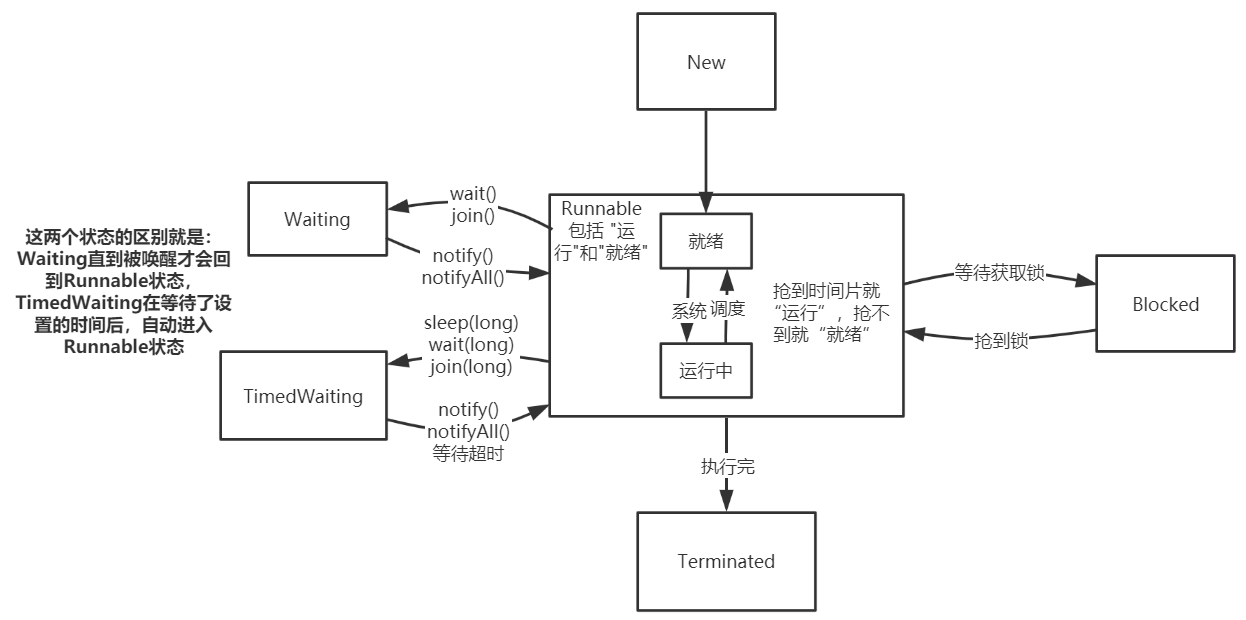本来想看 ThreadLocal 的源码的,但发现其中最重要的 get/set 方法都是操纵的 Thread 类 中的 threadLocals 变量 (java.lang.ThreadLocal.ThreadLocalMap),索性先来看一下 Thread 的源码吧,可以留意一下其中与 ThreadLocal 相关的属性,这样下次阅读 ThreadLocal 的核心 API 时,就能够轻易理解其原理咯。不多 BB,直接上硬菜。
实现多线程从本质上都是由 Thread 类 来完成的,其源码量很多,本次只看一些常见且重要的部分,源码和解析如下。
public class Thread implements Runnable {/** 这里只看一些 常见的参数 *//** 线程名 */private volatile char name[];/** 优先级 */private int priority;/** 是否为守护线程 */private boolean daemon;/** 线程要执行的目标任务 */private Runnable target;/** 所属线程组 */private ThreadGroup group;/** 类加载器 */private ClassLoader contextClassLoader;/*** ThreadLocal 能为线程设置线程私有变量 就是通过下面这个threadLocals变量完成的,* ThreadLocal的get/set方法就是通过操作 各个线程的 threadLocals 变量实现的。* 1、线程A持有一个 ThreadLocalMap 变量;* 2、线程A调用一个类的 ThreadLocal变量 tlA 的 get/set方法;* 3、tlA(ThreadLocal)的 get/set方法 获取当前线程A,调用 线程A 的 ThreadLocalMap变量 的get/put方法;* 4、其它线程 调用 tlA(ThreadLocal)的 get/set方法 同理。*/ThreadLocal.ThreadLocalMap threadLocals;ThreadLocal.ThreadLocalMap inheritableThreadLocals;/** 线程栈的大小 */private long stackSize;/*** Thread类定义了6个线程状态:New、Runnable、Blocked、Waiting、TimedWaiting、Terminated(终止)* 实际上还会把 Runnable 再细分为 就绪(未抢到时间片) 和 运行中(抢到时间片)*/private volatile int threadStatus;/** 最小优先级 */public static final int MIN_PRIORITY = 1;/** 中等优先级 */public static final int NORM_PRIORITY = 5;/** 最大优先级 */public static final int MAX_PRIORITY = 10;/*** 内部枚举类,用来描述线程状态,状态值有:* NEW: 新建,还未调用start()方法;* RUNNABLE: 运行,在java多线程模型中,就绪和运行都是运行状态;* BLOCKED: 阻塞;* WAITING: 等待,需要其他的线程来唤醒;* TIMED_WAITING:超时等待,可以在指定的时间内自动醒来,如 sleep()方法;* TERMINATED: 终止,线程执行完毕。*/public static final class State extends Enum {public static final State NEW;public static final State RUNNABLE;public static final State BLOCKED;public static final State WAITING;public static final State TIMED_WAITING;public static final State TERMINATED;private static final State VALUES[];static {NEW = new State("NEW", 0);RUNNABLE = new State("RUNNABLE", 1);BLOCKED = new State("BLOCKED", 2);WAITING = new State("WAITING", 3);TIMED_WAITING = new State("TIMED_WAITING", 4);TERMINATED = new State("TERMINATED", 5);VALUES = (new State[] { NEW, RUNNABLE, BLOCKED, WAITING, TIMED_WAITING, TERMINATED });}private State(String s, int i) {super(s, i);}}/*** 一系列 构造方法 ------------------------------------------------------* 可以看出来,其中都调用了init()方法,这也是一个约定俗成的规矩, 即,如果要在 new 时进行一些初始化操作,* 那么请将初始化操作单独写在 init()方法中,然后在构造函数中调用该 init()方法*/public Thread() {daemon = false;stillborn = false;threadLocals = null;inheritableThreadLocals = null;threadStatus = 0;blockerLock = new Object();init(null, null, (new StringBuilder()).append("Thread-").append(nextThreadNum()).toString(), 0L);}public Thread(Runnable runnable) {daemon = false;stillborn = false;threadLocals = null;inheritableThreadLocals = null;threadStatus = 0;blockerLock = new Object();init(null, runnable, (new StringBuilder()).append("Thread-").append(nextThreadNum()).toString(), 0L);}Thread(Runnable runnable, AccessControlContext accesscontrolcontext) {daemon = false;stillborn = false;threadLocals = null;inheritableThreadLocals = null;threadStatus = 0;blockerLock = new Object();init(null, runnable, (new StringBuilder()).append("Thread-").append(nextThreadNum()).toString(), 0L,accesscontrolcontext);}public Thread(ThreadGroup threadgroup, Runnable runnable) {daemon = false;stillborn = false;threadLocals = null;inheritableThreadLocals = null;threadStatus = 0;blockerLock = new Object();init(threadgroup, runnable, (new StringBuilder()).append("Thread-").append(nextThreadNum()).toString(), 0L);}public Thread(String s) {daemon = false;stillborn = false;threadLocals = null;inheritableThreadLocals = null;threadStatus = 0;blockerLock = new Object();init(null, null, s, 0L);}public Thread(ThreadGroup threadgroup, String s) {daemon = false;stillborn = false;threadLocals = null;inheritableThreadLocals = null;threadStatus = 0;blockerLock = new Object();init(threadgroup, null, s, 0L);}public Thread(Runnable runnable, String s) {daemon = false;stillborn = false;threadLocals = null;inheritableThreadLocals = null;threadStatus = 0;blockerLock = new Object();init(null, runnable, s, 0L);}public Thread(ThreadGroup threadgroup, Runnable runnable, String s) {daemon = false;stillborn = false;threadLocals = null;inheritableThreadLocals = null;threadStatus = 0;blockerLock = new Object();init(threadgroup, runnable, s, 0L);}public Thread(ThreadGroup threadgroup, Runnable runnable, String s, long l) {daemon = false;stillborn = false;threadLocals = null;inheritableThreadLocals = null;threadStatus = 0;blockerLock = new Object();init(threadgroup, runnable, s, l);}private void init(ThreadGroup threadgroup, Runnable runnable, String s, long l) {init(threadgroup, runnable, s, l, null);}/*** 初始化线程*/private void init(ThreadGroup threadgroup, Runnable runnable, String name, long l,AccessControlContext accesscontrolcontext) {// 参数校验,线程name不能为nullif (name == null)throw new NullPointerException("name cannot be null");this.name = name.toCharArray();// 当前线程就是该线程的父线程Thread parent = currentThread();SecurityManager securitymanager = System.getSecurityManager();if (threadgroup == null) {if (securitymanager != null)threadgroup = securitymanager.getThreadGroup();if (threadgroup == null)threadgroup = parent.getThreadGroup();}threadgroup.checkAccess();if (securitymanager != null && isCCLOverridden(getClass()))securitymanager.checkPermission(SUBCLASS_IMPLEMENTATION_PERMISSION);threadgroup.addUnstarted();// 守护线程、优先级等设置为父线程的对应属性group = threadgroup;daemon = parent.isDaemon();priority = parent.getPriority();if (securitymanager == null || isCCLOverridden(parent.getClass()))contextClassLoader = parent.getContextClassLoader();elsecontextClassLoader = parent.contextClassLoader;inheritedAccessControlContext = accesscontrolcontext == null ? AccessController.getContext(): accesscontrolcontext;target = runnable;setPriority(priority);if (parent.inheritableThreadLocals != null)// 创建线程共享变量副本inheritableThreadLocals = ThreadLocal.createInheritedMap(parent.inheritableThreadLocals);stackSize = l;// 分配线程idtid = nextThreadID();}public synchronized void start() {//假若当前线程初始化还未做好,不能start,0->NEW状态if (threadStatus != 0)throw new IllegalThreadStateException();//通知group该线程即将启动,group的未启动线程数量减1group.add(this);boolean started = false;try {// 调用native的start0()方法 启动线程,启动后执行run()方法start0();started = true;} finally {try {//启动不成功,group设置当前线程启动失败if (!started) {group.threadStartFailed(this);}} catch (Throwable ignore) {}}}private native void start0();public void run() {if (target != null)target.run();}/*** 请求终止线程。interrupt不会真正停止一个线程,它仅仅是给这个线程发了一个信号,* 告诉它要结束了,具体要中断还是继续运行,将由被通知的线程自己处理*/public void interrupt() {if (this != Thread.currentThread())checkAccess();synchronized (blockerLock) {Interruptible b = blocker;if (b != null) {interrupt0();b.interrupt(this);return;}}interrupt0();}private native void interrupt0();/*** 线程main 调用了线程A的join方法,则 线程main 会被阻塞,直到线程A执行完毕*/public final void join() throws InterruptedException {join(0);}/*** 实际上是利用 wait/notify机制 来实现的*/public final synchronized void join(long millis) throws InterruptedException {long base = System.currentTimeMillis();long now = 0;if (millis < 0) {throw new IllegalArgumentException("timeout value is negative");}// millis 为 0,所以走这个分支if (millis == 0) {// 当前线程是否还在运行,还在运行 则main线程 进入等待状态,直到 A线程运行完毕,将其唤醒while (isAlive()) {wait(0);}} else {while (isAlive()) {long delay = millis - now;if (delay <= 0) {break;}wait(delay);now = System.currentTimeMillis() - base;}}}/*** 线程睡眠指定的时间,释放CPU资源,但不释放锁*/public static native void sleep(long millis) throws InterruptedException;/*** 线程是否还在运行*/public final native boolean isAlive();}
之前一直对线程状态 及 状态切换的概念模糊不清,现在通过源码中对线程状态的定义,我们可以画张图来重新回顾一下,以使我们对其有更加深刻的理解。


